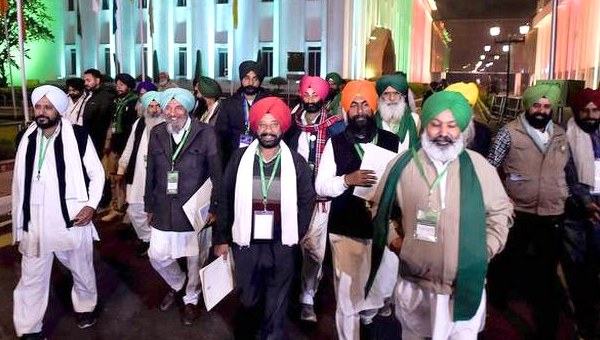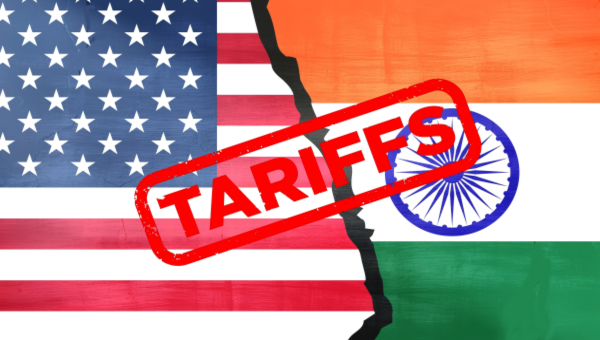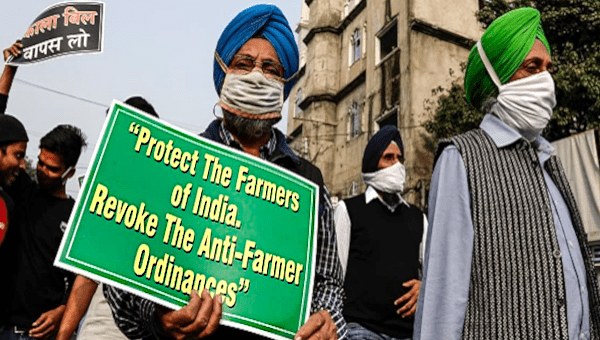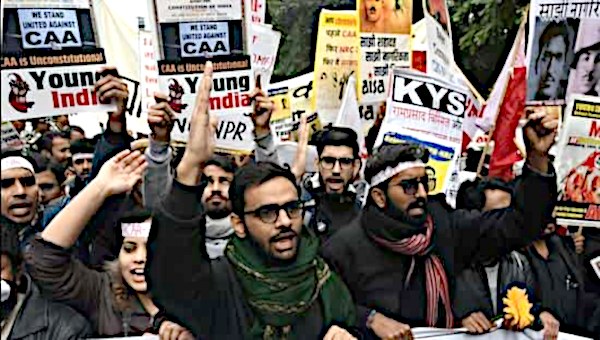Long March to Peasant Unity in India
The unprecedented unity among peasant organizations is not a sudden development. It has been built over several struggles, which have expanded the base of the peasant movement and snowballed into the massive protests against the new farm laws.
The talks between farmers’ organizations and the Union government over the controversial pieces of legislation governing agricultural marketing have reached a stalemate. The government is willing to consider a written assurance to continue with the Minimum Support Prices (MSP) mechanism, and amendments relating to the registration of private traders, imposition of cess (tax) on marketing outside APMC mandis (markets), legal recourse for dispute resolution in civil courts, and greater stringency in issuing licences to private traders. However, farmers’ representatives have unanimously rejected the amendments and also demanded the withdrawal of the Electricity Amendment Bill.

It is obvious that the firm resolve of farmers’ organizations is driving the negotiations. But it would be a mistake to regard this unity as a sudden development. It is the culmination of many streams of joint struggles, in Punjab and elsewhere in the past several years. The realities of a deeply differentiated peasantry notwithstanding, there is unity against the common threat of ceding total control to corporate houses, which are the obvious beneficiaries of the new legislation.
How the Negotiations Developed
Six rounds of talks were held between farmers’ organizations and the government until they collapsed on December 8. Amidst the protests and the rail roko campaign in Punjab, the government held the first two rounds of negotiations with farmer organizations from the State on October 14 and November 13. The organizations walked out of the first round of talks as it was not attended by a Union Minister. As the second round remained inconclusive, 32 farmer organizations decided to continue with their Dilli Chalo campaign.
The third round of negotiations was held on December 1 after farmers from Punjab and Haryana reached Delhi’s borders. In this round, farmers’ organizations rejected the government’s plan to constitute a committee to mediate the talks pointing out that it was a means to tire out the agitation. Later, that night Union Agriculture Minister Narendra Singh Tomar held a separate meeting with Rakesh Tikait of the Bharatiya Kisan Union (BKU). Farmer organizations saw this as a diversionary tactic. However, the intensified peasant unity forced Tikait to clarify that he stood by the demand for the repeal of the laws. Moreover, the invitation for the talks to just 32 farmer organizations from Punjab was interpreted as a sly tactic to portray the movement as the exclusive concern of farmers from Punjab.
In the fourth round of talks held on December 3, 35 negotiators, consisting of 32 Punjab farmers’ groups and representatives of the All India Kisan Sangharsh Coordination Committee (AIKSCC), yet again affirmed the primacy of annulling the three laws and the need to pass a fresh law that would give statutory effect to the MSP. The government issued statements suggesting its intention to bring amendments to the laws.
The Samyukt Kisan Morcha, a joint platform of Punjab farmers’ organizations, and other national groups decided unanimously on December 4 that the primary demand would be the nullification of the laws. As the fifth round of negotiations remained inconclusive the farmers’ organizations announced an all-India strike on December 8.
Meanwhile, Tomar met with 12 farmers from Haryana, who were reported to be representing Farmer Producer Organizations lending their support to the new laws. Media reports pointed out that several members of this handpicked team of “farmers” had close ties with the Bharatiya Janata Party. Tomar also held consultations with the Haryana Chief Minister amidst news that more MLAs of the Jannayak Janta Party (JJP), a part of the ruling alliance in the State, were coming out in support of the farmers.
On December 8, Home Minister Amit Shah entered the fray and held a late evening meeting with 13 farmer leaders (eight from Punjab and five from other organizations). This cherry-picking of organizations for an informal discussion on the eve of the sixth round of the talks was interpreted by some farmer groups as a means to destabilize their unity.
The government’s written proposals for amendments to the new laws reached the farmer organizations at the Singhu border on December 9. At a joint press conference, the Samyukt Kisan Morcha declared that it rejected the government’s proposal and that it would intensify the struggle until the laws were repealed.
Punjab – Unity in an Unequal Rural Landscape
Since colonial times, Punjab has witnessed many waves of organized peasant movements. The composition of the farmer organizations represented at the talks, and of those lending support to the agitation, shows the spectrum of ideological positions of those participating in the agitation. Among them are multiple break-away groups of the Bharatiya Kisan Union, the leftist Kisan Sabha and other ultra-left farmer organizations.
After a hiatus in the farmers’ movement during the years of militancy, a new phase of united struggles in Punjab emerged in the early 2000s. The joint struggle of five farmer organizations then was with regard to timely procurement by the Food Corporation of India, remunerative prices, and other forms of agricultural support. These joint struggles were organised against the backdrop of increasing indebtedness among the peasantry as a result of falling foodgrain productivity and rising cost of cultivation. A study commissioned by the Punjab State Farmers Commission in 2008 found that 89 per cent of farm households in the State were indebted. Small cultivators were more heavily indebted on a per hectare basis.
This was also when farmer organizations in Punjab held joint campaigns against the Agreement on Agriculture passed by the World Trade Organization as it directly attacked farm subsidies and public stockholding of foodgrains. Sukhdev Singh Kokri, State general secretary of the BKU Ekta (Ugrahan) – one of the biggest farmers’ organizations from Punjab – who claim to have mobilized 1.5 lakh peasants along the Delhi-Rohtak expressway, said the success of the prolonged campaign against the WTO could be seen in the farmers’ understanding of the real intent of the new laws.
Punjab was not untouched by the coalition of peasant organizations demanding implementation of the Swaminathan Commission’s recommendations, which identified remunerative prices and loan waivers, among others, as key issues for the Indian peasant. The formation of an umbrella, the AIKSCC, was a result of this nationwide mobilization campaign on the same issues.
Farmers’ organizations in Punjab started their protests against the farm laws as soon as they were introduced as ordinances in June. Despite the lockdown, protests at the village level were organised from rooftops. At first there was coordinated action among 10 organizations having a presence in different parts of Punjab; as the protests intensified the coalition expanded to include more than 30 organizations. As the new laws were rammed through Parliament in September, the organizations started a rail roko from September 25. Demonstrations were held in Chief Minister Amarinder Singh’s hometown and National Democratic Alliance partner and Akali Dal leader Parkash Singh Badal’s village. The political power exercised by the Punjab peasantry, especially the Jat Sikhs, could be seen as the Akali Dal Minister in the Union Cabinet, Harsimrat Kaur, resigned.
Bharatiya Kisan Union
Organizations such as the BKU Ekta (Ugrahan) have continued to function independently, although in coordination with the larger coalition of farmer organizations during the present agitation. Formed in 2002, as a breakaway faction of the BKU, the BKU (Ugrahan) is active in 13 districts of the State. It has consciously shifted from the BKU’s original constituency, the rich Jat farmer, a key beneficiary of the Green Revolution, to a more diverse class of peasants, including small and marginal farmers. It is also behind the successful participation of a large number of women in the Delhi protest through its dedicated women’s wing. Sukhdev Singh Kokri said the ongoing struggle has been unlike previous united movements, which suffered from political interference.
The Agricultural Produce Marketing Committee (APMC) mandi system, in conjunction with the MSP policy, played a central role in the success of the Green Revolution. The resulting increase in yields and output made it possible for all sections of the peasantry to generate a surplus that was available for the market, primarily through APMC mandis. The mandis not only ensured sustained incomes for peasants but also played a role in supporting an ecosystem of other interrelated trades and petty businesses. In the 1970s and 1980s, while the BKU led the movement for greater prices, public procurement and state support for inputs, it largely remained as a rich Jat Sikh movement. However, in more recent times, peasant organizations, including breakaway factions of the BKU and the leftist groups, have expanded their bases by mobilizing small and marginal farmers. The agitation against the new laws has galvanized the different strata of peasantry into a common platform and struggle.
Thin Presence of Dalit Landless Workers
Although the presence of Dalit agricultural workers and landless peasants from Punjab has not been completely missing at the protest sites, there is a lack of ownership of the movement by these sections. Despite Punjab having one of the highest concentrations of landless Dalit households in the country, the ongoing protests have largely been a peasant, rather than a peasant-worker movement. Of course, for a Dalit and landless worker, among the poorest in the Punjab countryside, to travel all the way to a protest site near Delhi is much more difficult compared with other sections of the peasantry. It would be a mistake to take their thin presence in the protests as a sign of apathy to the cause.
Nevertheless, one of the reasons for the Dalit worker’s reticence has been the longstanding schism between the landed Jat sections and the Dalit agricultural labourers, which has aggravated since the COVID lockdown. Due to the shortage of migrant agricultural workers during the lockdown, the landowners had to depend on Dalit Sikh labourers from their own villages to carry out the harvesting operations. Conflict erupted as Jat landowners set up their own panchayats to decide wages and announced them from gurudwaras. Boycott campaigns were run against Dalit labourers who refused to work at the declared wages. The bargaining power of agricultural workers has reduced in the State over the years.
As part of an incipient Dalit land rights movement in Punjab, the Zameen Prapti Sangharsh Committee (ZPSC), a radical formation, has been leading struggles demanding one-third panchayat lands for cooperative farming by landless Dalit families. More recently, it started a campaign to identify landowners possessing surplus land beyond the legal limit of seven hectares (for irrigated and multi-crop agricultural land) stipulated under the Punjab Land Reforms Act. At present the ZPSC is active in about 110 villages, across Sangrur, Patiala, Barnala and Mansa districts.
Mukesh Malaud, zonal president of the ZPSC, says the limited participation of Dalits and agricultural workers in the agitation points to the distrust between upper caste landed peasants and landless Dalit workers. However, Mukesh Malaud adds that the leftist peasant organizations have tried to resolve the recent conflicts between small landowners and Dalit labourers. He believes that the presence of Left organizations in the current agitation has created some possibilities of forging solidarity.
The ZPSC emphasises the adverse consequences that would follow the implementation of the Essential Commodities (Amendment) Act. The removal of restrictions on stocks held by large traders may result in a runaway spiral of food prices, a major worry for the labouring classes. Additionally, the closure of mandis would lead to large-scale loss of livelihoods. Other peasant organizations, in an effort to forge solidarities across class lines, have also started to articulate their opposition to the new laws in terms of their effect on food security.
Samyukt Kisan Morcha
The organized struggle of Punjab farmer groups has been bolstered by the alliance at the national level which has doused the government’s projection that the opposition to the new laws is limited to Punjab and Haryana. These broad-based farmers’ alliances have also been able to build a discourse around agrarian distress in the past few years.
The AIKSCC was the first to act towards building a national platform of farmer organizations on a common agenda with its demand to implement the Swaminathan Commission recommendations, seeking remunerative prices at C2+50 per cent costs and debt relief. Formed in 2017, just after the Mandsaur firing in Madhya Pradesh that killed five farmers, the AIKSCC comprises more than 250 farmer organizations in the country. Since then, it has initiated a series of protests and campaigns. After nationwide public consultations, it prepared The Farmers’ Freedom From Indebtedness Bill and The Farmers’ Right to Guaranteed Remunerative Minimum Support Prices for Agricultural Commodities Bill and got them introduced in Parliament as private Bills in 2018. The Bills received endorsement from 21 opposition parties. On November 29-30, 2018, the AIKSCC organised the Kisan Mukti March in Delhi, bringing together hundreds of farmers, peasants and agricultural workers from all over India to demand a special Parliament session to discuss the country’s agrarian distress. This was preceded by the Sikar farmers’ agitation in 2017 and the Kisan Long March in 2018, both organized by the All India Kisan Sabha (AIKS), a major constituent of the AIKSCC. In the Kisan Long March, hundreds of peasants walked from Nashik to Mumbai, covering 180 km in six days. The common thread in all these struggles was opposition to the economic policies of the Central and State governments, which have reduced agriculture to a non-remunerative enterprise and a guaranteed cycle of debt for the peasantry.
Soon after the introduction of the three farm ordinances on June 5, the AIKSCC organized demonstrations across the country. Activists took to social media to express their protest, given the COVID lockdown restrictions on large gatherings. On August 9, AIKSCC groups and central trade union bodies jointly held nationwide protests against both the farm and labour ordinances. Again, on September 25, after the Bills were passed in the winter session of Parliament with little discussion and much opposition, the AIKSCC organised protests across the country.
On October 27 a joint meeting was held between the AIKSCC working group members and farmer organizations from Punjab and Haryana. The call for a Dilli Chalo protest on November 26-27 was jointly adopted by this coalition which came to be called the Samyukt Kisan Morcha (SKM), comprising more than 30 farmer organizations from Punjab, along with the AIKSCC. The SKM also includes the Rashtriya Kisan Mazdur Mahasangh (RKMS), a coalition of 180 organizations led by Shivkumar Sharma Kakkaji, which broke away from the Bhartiya Kisan Sangh (BKS). The BKU is also a constituent of the SKM. There are at present about 500 groups under the SKM. The ongoing agitation at the Delhi borders is under the aegis of the SKM.
Prepared for the Long Haul
Coming out of the meeting with the Home Minister on December 8, AIKS general secretary and AIKSCC leader Hannan Mollah said peasant organizations were against cosmetic changes to the laws. On December 9, the SKM, while rejecting the proposal for amendments, outlined its plans for a prolonged agitation. The farmers’ arguments for rejecting the amendments stand on the principles of exercising constitutional autonomy granted to State governments and the lack of any public discussion around the three laws before they were introduced. The farmers argue that the intent behind the new laws is to introduce greater corporate control in Indian agriculture, which endangers national food security.
Farmers’ organizations have called for an all-India protest on December 14. In addition to the seven borders connecting Delhi to Haryana and Uttar Pradesh, farmers plan to block the Jaipur highway on December 12. Farmers from Rajasthan, who were busy until now with local body elections, would reportedly join at the Delhi border . There is a call given to farmers from Delhi’s neighbouring States to join at the borders. Punjab’s farmer organizations have repeatedly said they are prepared to continue the struggle for six months. They have devised a mechanism to rotate the protesting farmers at the borders. The BKU Ekta (Ugrahan) said more farmers from Punjab would reach Delhi as the rabi wheat sowing season was nearing its end.
The renewed campaign slogan “Sarkar ki Majboori – Adani, Ambani, Jamakhori” (The government is beholden to the hoarders – Adani, Ambani) identifies the corporates as the common threat. Farmer organizations have given a call to boycott all Jio, Reliance and Adani products, including malls, toll plazas and mobile sim cards. The peasants’ struggle has been a long and tortuous haul. In the process it has sharply and imaginatively focussed its wrath on the growing and identifiable nexus between corporate interests and the Narendra Modi government’s policies. This may well prove to be the lasting contribution of a movement that has unified like never before in recent memory. •
This article first published on the Focus on the Global South website.





